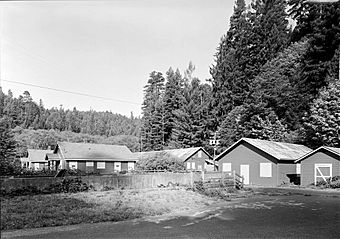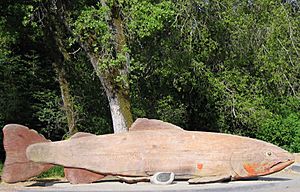Prairie Creek Fish Hatchery facts for kids
Quick facts for kids |
|
|
Prairie Creek Fish Hatchery
|
|

Hatchery complex
|
|
| Location | State Highway 101, Milepost 124.83 North of Orick, California (Redwood National and State Parks) |
|---|---|
| Area | 6.2 acres (2.5 ha) |
| Built | 1936 |
| Architect | California Division of Architecture |
| Architectural style | Late 19th And 20th Century Revivals |
| NRHP reference No. | 00000034 |
| Added to NRHP | 04 February 2000 |
The Prairie Creek Fish Hatchery near Orick, California in Humboldt County, California was a special place built to help more fish grow. It was one of the first fish hatcheries in the area. Its main goal was to improve fishing for both fun (sport) and for people who caught fish to sell (commercial fishing). This hatchery is one of only three like it still standing in California that were built between 1871 and 1946.
Contents
History of the Hatchery
In 1927, experts explored streams along California's north coast. They found many coast cutthroat trout eggs in Lost Man Creek, which flows into Prairie Creek. About a year later, they built traps and a temporary hatchery there.
Early Success and Expansion
By spring 1928, the temporary hatchery had 30 troughs. These troughs held 208,000 Coho salmon eggs and 1,400,000 steelhead eggs. Fresh water was very important. It came from a 12-inch wide flume (a channel for water). This flume was almost 2,500 feet long. It brought water from behind a dam on Lost Man Creek.
The temporary hatchery worked very well. Because of this success, the hatchery project continued into the early 1930s. They released many fish into the wild. These included steelhead, cutthroat trout, Coho salmon, and King salmon.
Building the Permanent Hatchery
The first temporary hatchery site was later closed. A new, permanent hatchery was built in 1936. It was placed on about the same spot. Today, this historic area is 62 acres. It includes five main buildings and seven other important structures. These are the hatchery building, the superintendent's house, the assistant's house, sidewalks, a garage shop, a shed, a pipeline stream crossing, and four round outdoor water tanks. A fifth tank was added later.
Over the years, some buildings were changed or removed. The original dam and reservoir (a place to store water) were taken out in 1989.
Changes Over Time
The hatchery kept raising trout and salmon during the 1940s. However, the water supply started to get worse. This happened as more machine-based logging (cutting down trees) increased after World War II.
In 1957, Humboldt County began running the hatchery. The state of California officially gave the property to Humboldt County on September 15, 1961. The hatchery continued to operate until October 31, 1992, when it closed.
The Amazing Story of Indomitable Salmon

On December 2, 1964, something incredible happened. Ken Johnson, the Hatchery Superintendent, found a two-year-old marked coho salmon swimming in a tank of newborn fish. This was the exact tank where he had been raised two years earlier!
An Incredible Journey
To reach that tank, this salmon had to make an amazing journey.
- First, he traveled from the Pacific Ocean.
- Then, he swam up Redwood Creek.
- Next, he turned into Lost Man Creek.
- He then went up a ditch.
- He swam through a 1.5 feet (0.46 m) culvert (a pipe under a road) under Highway 101.
- He continued through a storm sewer.
- Finally, he swam up the hatchery waste water through a 4 inches (10 cm) drainage pipe. Inside this pipe, he made a 90-degree turn and jumped 2.5 feet (0.76 m) vertically.
- To get into the rearing pond, he likely jumped and rammed through an overhead wire mesh screen.
A Famous Fish
The local newspapers quickly nicknamed the fish Indomitable. This means "impossible to defeat." Workers then looked for how he got into the tank. They found 72 more marked coho "jack" salmon (young male salmon) of the same age. These fish were stuck in the flume or drainage pipe on their way to the hatchling pond.
The story of Indomitable became very famous. It received a lot of press coverage and even inspired a book. It is still talked about today as one of the most amazing feats of animal migration.
Indomitable Sculptures
From 1974 to 1992, two large redwood sculptures of Indomitable were placed outside the hatchery. The first sculpture was 22 feet (6.7 m) long and weighed two tons. It was made by Floyd Davis in 1974. This was possible thanks to money raised by Ed Henke.
By 1992, the first sculpture was too old and weathered to be displayed. A second fish sculpture was then carved on site by Mark Leppanen. This was made possible by donations from local companies and a county supervisor. When the Hatchery closed in 1992, the second sculpture was moved. It was stored at the Arcata/Eureka airport. In 1997, it was sold to a grocery store in Arcata for $5,005. It is now displayed inside that store.
At Prairie Creek today, you can still see the pole where Indomitable's sculptures were mounted. There is also a concrete pad and a dedication marker. The original Davis sculpture was sold and is now outside Buck's of Woodside restaurant.



